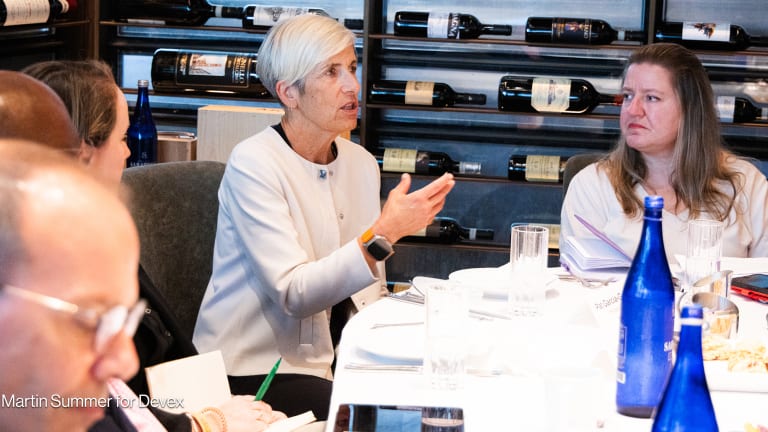
Noncommunicable diseases, or NCDs — such as heart and respiratory diseases, diabetes, and cancer — have become the leading cause of death worldwide, claiming 41 million lives annually. The majority of these deaths — 73% — occur in low- and middle-income countries, or LMICs, where health systems are often underresourced and unprepared for long-term chronic care.
Efforts to expand infrastructure, train health care workers, and improve access to medicines have been helpful, but systemic barriers persist. Fragmented financing, regulatory hurdles, and weak primary care continue to stall progress.
At a recent roundtable on the sidelines of the 78th World Health Assembly, hosted by Devex in partnership with Sanofi’s Global Health Unit, 13 leaders from government, civil society, impact investment companies, and the private sector convened to discuss how integrated partnerships can drive more equitable and sustainable financing models for NCD care.
With the fourth high-level meeting of the United Nations General Assembly on NCDs and mental health on the horizon, participants agreed that only through coordinated action across sectors — involving governments, industry, nongovernmental organizations, and communities — can countries deliver lasting impact.
These were the key takeaways from the discussion.
Public-private partnerships are key to scaling impact
In health systems facing limited public funding and rising demand for NCD care, public-private partnerships, known as PPPs, are emerging as critical tools to fill service gaps and scale access. Yet structuring and managing these partnerships remains complex.
The case of Somalia was discussed as an example of both the promise and complexity of PPPs in action. In a country where nearly 60% of health services are provided by private players, the government has begun formalizing partnerships to strengthen access to care — including for NCDs. The launch of Mogadishu’s first PPP hospital in 2016 illustrates how care can be scaled — even with limited public infrastructure and amid broader instability, care can be scaled through structured partnerships.
Participants also pointed to the success of the Aga Khan network, a collection of international hospitals and health centers operating in Africa and central Asia and partially supported by governments such as Germany’s, as proof that public-private systems can thrive when backed by clear rules and long-term investment.
The key, according to one speaker, could be a “hybrid PPP” model, which “de-risks the public sector's obligation towards a private sector provider,” lowering investment risk by providing up-front capital or guaranteeing government payments. “The minute you provide long-term visibility and predictability, private investors can work backward. If you don’t have that … you don’t invest.”
Part of efficiently leveraging PPPs also involves recognizing what’s already working — and ensuring the push for progress doesn’t interfere. “We need to be honest about whether we’re enabling or disrupting working solutions,” one participant said. Effective PPPs know when to hold off — and when to reinforce local progress.
The success of PPPs hinges, too, on strong governance and oversight. “Contract management is the weakest link,” one speaker warned, noting that “if supervision is lacking, the private sector providers — whether of good faith or less [good faith] — would have a problem.”
Innovative financing models can unlock necessary investment
Financing remains a critical bottleneck. Globally, the economic cost of the five major NCDs is projected to surpass $47 trillion by 2030 — yet only a fraction of global health funding is directed toward NCDs. While progress has been made, health still struggles to attract capital. “Most impact investing goes to climate or, nowadays, even the defense industry,” one speaker noted.
Another highlighted that, in LMICs, “there’s just not enough money and not enough people to treat the growing number of people with NCDs.” They continued on to emphasize the private sector’s leverage: “Startups and early-stage companies can bring innovative solutions for prevention, self-management, and supply chains. But they need risk-bearing capital to do it.”
Blended finance, which combines public and private funds to reduce investment risk, is a potentially promising tool to address the resource gaps for NCD prevention and treatment, particularly in challenging markets. In the words of one participant, “Impact investment can be a game changer if we can de-risk and build ecosystems that attract these funds."
However, two major challenges remain. The first is how to channel more blended finance into health, given that the sector “is still considered very high-risk and low-returns” and is “very complex,” as noted by one participant.
The second challenge is integrating these innovations into public health systems. Even when promising technologies exist, small health tech companies struggle to access public procurement markets — especially in LMICs. But private pharmaceutical companies could play a vital role by collaborating through partnerships to bridge these innovators with the public sector — “this is a major missed opportunity right now,” according to one speaker.
Cross-country collaboration can help to break silos
Ultimately, “any problem we have [with one NCD], there will be a country where this is solved. The problem is we don’t [hear] from each other,” one speaker noted, highlighting the persistent challenge of knowledge gaps between countries tackling similar issues.
The conversation also touched on the difficulty of breaking deeply rooted silos — “we have four companies doing four different projects with the same population,” as one participant referenced — which stifle progress and hinder collaboration. “It will be impossible to achieve SDG 3.4 [reduction of premature mortality from NCDs by one-third] in silos [with] each sector developing and implementing in isolation,” one participant told Devex after the event.

Several participants pointed to the need for more intentional structures that allow for peer exchange and real-time collaboration across borders. Some industry initiatives are trying to change that by building data-driven models that facilitate country-to-country learning, including best-practice sharing across regions to avoid repeating mistakes made elsewhere.
Showing countries what’s possible through successful models can create a positive competition — a “FOMO [fear of missing out]” effect, in the words of one participant — that drives broader adoption and innovation. When best practices are made visible and accessible, they not only offer technical guidance, but inspire momentum across borders.
Strengthening local ecosystems remains key
Even the most well-intentioned partnerships can falter without deep engagement from local systems and communities. Experts agreed that tackling NCD care requires moving beyond reliance on pharmaceutical companies alone. “You cannot ask the industry to deliver a service to patients. There is a limit to what they can do,” one speaker said. “I think we've been in that model, which I think is the wrong model.” Instead, the focus should be on working with local ecosystems to build strong in-country structures that national health services can sustain.
A successful example comes from India, where early investment in NephroPlus, the country’s largest dialysis network, helped develop affordable dialysis sessions. “It’s not the industry delivering the service,” the participant said, “but the ecosystem in-country that makes it work,” delivering the service “at a cost-efficient basis.”
Sustainable impact depends, however, on national health systems being able to afford these integrated, community-driven models. And such models are only possible with cross-sector collaboration, which ensures care reaches the “last mile” — those who are not typically reached by health care services, especially in low- and middle-income countries.
Tackling the NCD crisis in LMICs, then, will require more than innovation — it demands bold collaboration, aligned investment, and a shared commitment to strengthening health systems from the ground up.
Visit Accelerating Action — a series highlighting pathways for funding NCD prevention and control, spotlighting innovative financing models and cross-sector collaborations.
This content is sponsored by Sanofi as part of our Accelerating Action series. To learn more about this series, click here.









